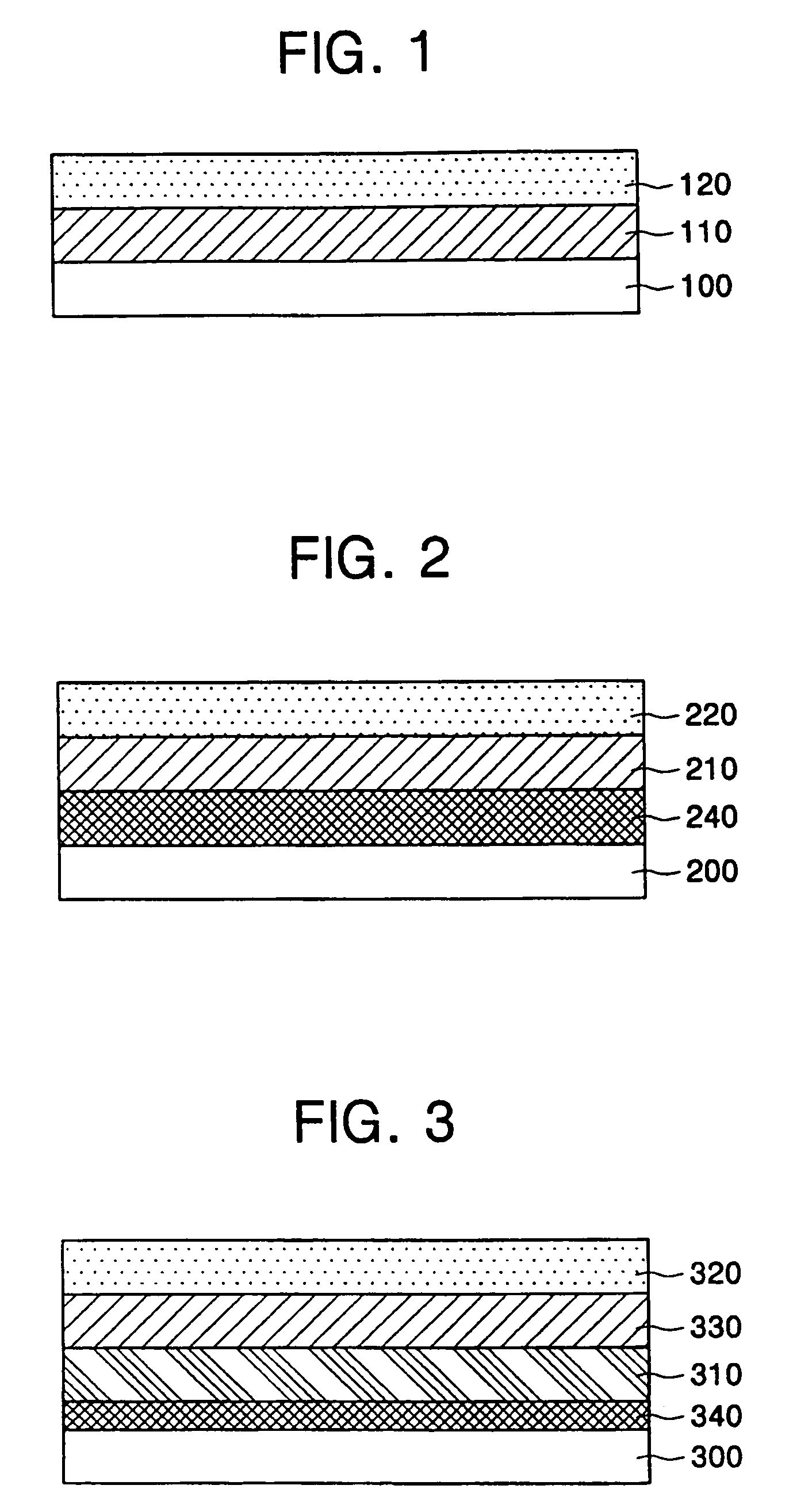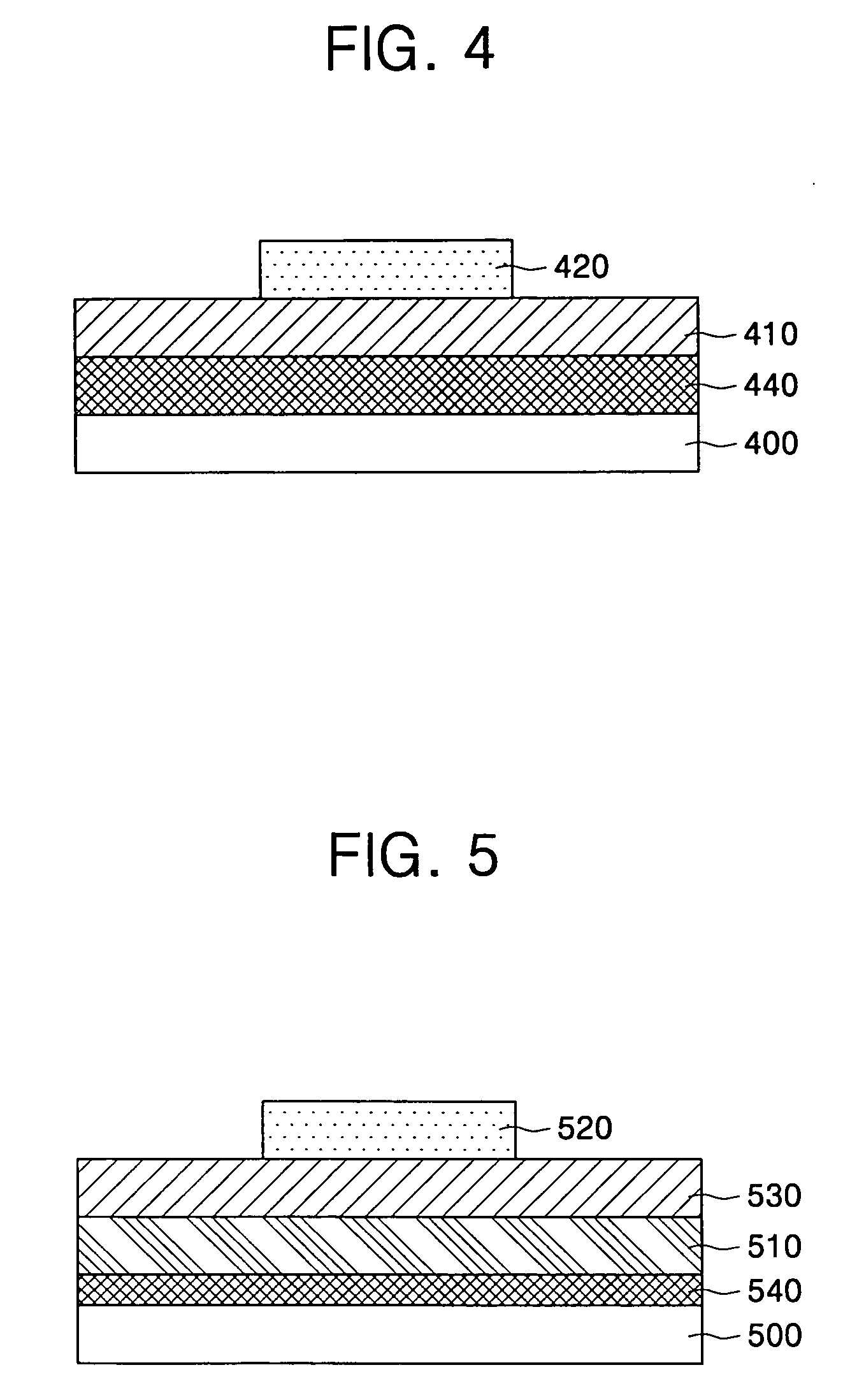Thermal transfer element
a technology of transfer element and lithography method, which is applied in the field of thermal transfer element, can solve the problems of reducing yield, difficult to form fine patterns, and difficulty in lithography, and achieve the effect of improving transfer characteristics and low energy consumption
- Summary
- Abstract
- Description
- Claims
- Application Information
AI Technical Summary
Benefits of technology
Problems solved by technology
Method used
Image
Examples
first embodiment
[0028]FIG. 2 is a cross-sectional view of a laser thermal transfer element for forming an organic thin film layer of an OLED in accordance with the present invention.
[0029]Referring to FIG. 2, a laser thermal transfer element in accordance with a first embodiment of the present invention includes a base substrate 200, a light-to-heat conversion (LTHC) layer 210, and a transfer layer 220. The base substrate 200 functions as a support substrate for supporting the laser thermal transfer element. The base substrate 200 is made of a transparent polymer, such as polyester, polyacryl, polyepoxy, polyethylene, polystyrene, polyethylene terephthalate or the like, and has a thickness of about 10˜500 μm. The base substrate 200 may employ a substrate, such as a glass substrate, or a film.
[0030]The LTHC layer 210 absorbs light so as to convert the light to thermal energy, and it has an appropriate optical density and includes a light-absorbing material. The light-absorbing material is a material...
second embodiment
[0038]FIG. 3 is a cross-sectional view of a laser thermal transfer element for forming an organic thin film layer of an OLED in accordance with the present invention.
[0039]Referring to FIG. 3, the thermal transfer element in accordance with a second embodiment of the present invention includes a base substrate 300, a light-to-heat conversion (LTHC) layer 310, and a transfer layer 320. The base substrate 300, the LTHC layer 310 and the transfer layer 320 are formed in a manner similar to that in the first embodiment.
[0040]The thermal transfer element in accordance with a second embodiment of the present invention further includes a release layer 340 formed between the base substrate 300 and the LTHC layer 310, and an interlayer 330 formed between the LTHC layer 310 and the transfer layer 320.
[0041]The interlayer 330, preferably, has a high thermal resistance, functions to protect the LTHC layer 310, and uses an organic layer, an inorganic layer, and a stacked layer of the organic lay...
third embodiment
[0042]FIG. 4 is a cross-sectional view of a laser thermal transfer element for forming an organic thin film layer an OLED in accordance with the present invention.
[0043]Referring to FIG. 4, the thermal transfer element in accordance with a third embodiment of the present invention includes a base substrate 400, a light-to-heat conversion (LTHC) layer 410, and a transfer layer 420. The thermal transfer element further includes a release layer 440 formed between the base substrate 400 and the LTHC layer 410 to facilitate delamination of the LTHC layer 410 from the base substrate 400.
[0044]The base substrate 400, the LTHC layer 410 and the release layer 440 are formed in a manner similar to that in the first embodiment. Unlike the transfer layer 220 of the first embodiment, however, the transfer layer 420 is patterned. When the OLED is manufactured using the thermal transfer element in accordance with a third embodiment of the present invention, the transfer layer 420 includes at least...
PUM
| Property | Measurement | Unit |
|---|---|---|
| glass transition temperature Tg | aaaaa | aaaaa |
| thickness | aaaaa | aaaaa |
| thickness | aaaaa | aaaaa |
Abstract
Description
Claims
Application Information
 Login to View More
Login to View More - R&D
- Intellectual Property
- Life Sciences
- Materials
- Tech Scout
- Unparalleled Data Quality
- Higher Quality Content
- 60% Fewer Hallucinations
Browse by: Latest US Patents, China's latest patents, Technical Efficacy Thesaurus, Application Domain, Technology Topic, Popular Technical Reports.
© 2025 PatSnap. All rights reserved.Legal|Privacy policy|Modern Slavery Act Transparency Statement|Sitemap|About US| Contact US: help@patsnap.com



